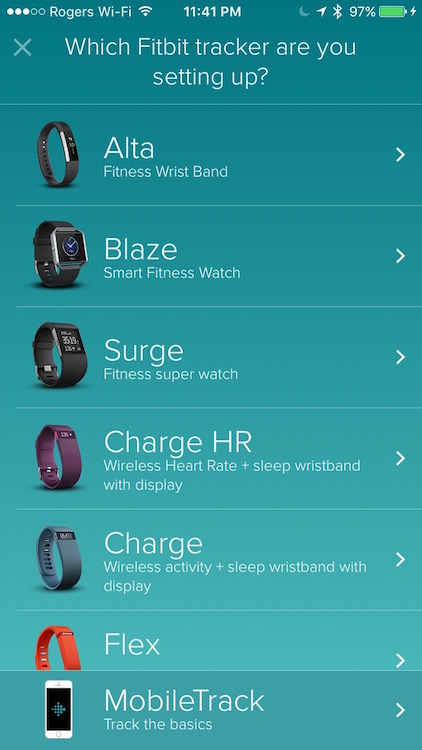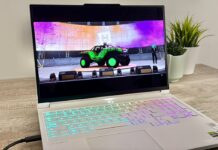
 The FitBit Blaze is an interesting hybrid of fitness tracker and smart watch; it’s packing in a lot of the same features without going down the road of actually answering calls or texts, or having a full app ecosystem. For many consumers that’s actually a plus: keeping things simple is great, doing it at a lower price is even better. So what do you get when you buy a FitBit Blaze and strap it on? Let’s sum it up.
The FitBit Blaze is an interesting hybrid of fitness tracker and smart watch; it’s packing in a lot of the same features without going down the road of actually answering calls or texts, or having a full app ecosystem. For many consumers that’s actually a plus: keeping things simple is great, doing it at a lower price is even better. So what do you get when you buy a FitBit Blaze and strap it on? Let’s sum it up.
The Blaze does a lot of your regular FitBit stuff: it tracks the steps you’ve taken, and the distance those steps have taken you. A lot of us have set an arbitrary goal of about 10,000 steps per day; it’s a great way to ensure you’re getting enough exercise, even for those with sedentary jobs.
In addition to tracking your steps, the Blaze (like the rest of the FitBit lineup) tracks your calorie burn for the day; you burn calories at a natural rate–and your FitBit will account for that–but it will also monitor the exercise you engage in, helping you visualize your total calorie burn for the day. That, in combination with nutrition tracking (which you can do with the FitBit app by recording everything you eat) can help you ensure that you’re running at a calorie deficit if you’re looking to lose weight, or that you’re eating enough for the muscle you’re trying to build if you’re doing that.
FitBit has some fun metrics that it records too; it tracks how many flights of stairs that you climb, and how many minutes you’re active during the day. Personally I walk up a bunch of flights each day at New Westminster station and Granville station on the SkyTrain line, so it was a number I liked to keep an eye on with my own FitBit.
One of my favourite parts of being in the FitBit community is the way that it connects you with friends; the Blaze ties in with the FitBit app and the FitBit site, where you can connect directly with friends and family. I bought a Flex for my mom and dad each, and even though they’re 3000km away in Ontario I can still see how they’re doing and cheer them on when they hit their goals. It’s been fun for us to challenge each other; my mom’s the reigning step champion–there are days when she knocks off 20,000 steps. It’s actually rather impressive. Go mom!
Tracking your progress is a big part of owning a FitBit, and out of the whole family the Blaze is the very best way to see your results in real time. It has a beautiful, large colour touchscreen that responds as you tap it. There are some physical buttons on the side of the watch-band’s frame which help it behave more like a traditional digital watch. Through these features you can start and stop workouts and get an accurate look at how you’re doing when you’re working out.
Unboxing the Blaze
The FitBit Blaze comes in a rectangular package with a cover that slides off to reveal a box that’s sealed by a magnet. Pulling that open you’ll find the Blaze installed in a watchband, and two small cardboard packages below–one with the USB charger and one with a small paper manual and a slip of paper that directs you to fitbit.com/setup
I visited the website, where it encourages you to set up your device on your phone; I went into the FitBit app and selected “add a device” and stepped through a quick process that paired the Blaze with my phone and with my FitBit account. This was actually the most painless FitBit setup I’ve ever done; the older models had a plug-in that came with them and always seemed to take one or two tries, where the Blaze was setup instantly. It asked me to update it right away, a process that took about ten minutes.
I charged the Blaze up from there, which is the only part of the process I found to be clunky. My Apple Watch has a beautiful induction charger; it clips magnetically onto the back of the device and charges it overnight. The Blaze, on the other hand, requires you to eject it from the band, clip it into a charging bracket, and to plug it into a USB port (it doesn’t come with a power adapter). It took less than two hours to charge fully, and as the evening was drawing to a close I decided to wear the Blaze to bed to do some sleep analysis.
Unlike older FitBit models, I didn’t have to let the app know I was sleeping or that I was waking up in the morning; it automatically moved into sleep monitoring mode when it detected that I was asleep, and woke me up with a gentle wrist vibration in the morning. You can see from the screenshot how I slept that night. You can set alarms using the FitBit website or app; it’s a bit frustrating that you can’t set an alarm on the watch itself.
Work it while you work out.
From there I went to the gym and worked out. One of my favourite features of the FitBit Charge HR devices was heart rate tracking. I set the Blaze to track workouts with the built-in app; you can choose the type of exercise you’re about to engage in, running, cycling, weights, or workout. The PurePulse™ heart rate sensor consists of two green LEDs that illuminate your skin and can track how fast your heart is beating by the blood passing through the vessels underneath. This is a tried-and-true technology that is used by a variety of different fitness bands, and I can confirm that it’s as accurate as other devices that I’ve used like the Apple Watch.
 I really like that my resting heart rate and the amount of steps I’ve taken is displayed right on the front watch face; it’s a very quick way to see how I’m doing at any point in the day. There are a variety of watch faces that you can pick, I really like the “Pop” face, but all four of them are pretty cool. I like Pop for the larger clock display, and tapping on the display cycles you through steps taken, heart rate, and calories burned.
I really like that my resting heart rate and the amount of steps I’ve taken is displayed right on the front watch face; it’s a very quick way to see how I’m doing at any point in the day. There are a variety of watch faces that you can pick, I really like the “Pop” face, but all four of them are pretty cool. I like Pop for the larger clock display, and tapping on the display cycles you through steps taken, heart rate, and calories burned.
Using the FitBit Blaze is just as easy as any other FitBit, but the user experience, in my opinion is far better. The big, clear screen and touch interface makes it a fantastic experience. It’s much easier to navigate through to important information, and it makes it very quick to get started with a workout.
Much like the Apple Watch, the FitBit Blaze is customizable with different watch bands. Swapping between them is simple, as the unit itself pops out of the wrist-band frame (just like you do when you have to charge it). I like that you can customize the look, but I’m not a huge fan of the bracket that you can snap the device into; it feels chunky. Still, it’s a FitBit that is easy to use, and looks relatively good.
FitBit “Apps”
 The last thing I’d like to touch on are the apps that come with the Blaze. Swiping from right to left takes you through each app, and tapping on it opens the app itself. “Today” gives you the breakdown of all of the information I talked about above – heart rate, steps, distances, calories burned, floors climbed, and so on. Exercise allows you to start recording a workout. FitStar is a cool app that gives you directions for bodyweight workouts; that’s great if you don’t have access to a gym or gym facilities, with a warmup, a 7-minute workout, and 10 minute abs. Timer includes both stopwatch and countdown, which can be handy if you’re doing HIIT or if you’re timing a countdown between sets.
The last thing I’d like to touch on are the apps that come with the Blaze. Swiping from right to left takes you through each app, and tapping on it opens the app itself. “Today” gives you the breakdown of all of the information I talked about above – heart rate, steps, distances, calories burned, floors climbed, and so on. Exercise allows you to start recording a workout. FitStar is a cool app that gives you directions for bodyweight workouts; that’s great if you don’t have access to a gym or gym facilities, with a warmup, a 7-minute workout, and 10 minute abs. Timer includes both stopwatch and countdown, which can be handy if you’re doing HIIT or if you’re timing a countdown between sets.
Alarms, as I’ve mentioned, have to be set through the FitBit website or app, so it’s handy for seeing but not setting. Settings gives you access to some minimal settings, with the majority of them being set through the phone app.
The FitBit Blaze is the natural evolution of FitBit into smartwatch. It gives you caller ID, text alerts, and some control over your phone’s music, in addition to giving you a big, beautiful interface, a heart-rate monitor, and smarter apps to play with.
If you’re in the FitBit ecosystem or if you’re looking for an economical way to get most of the features of some more premium smartwatches, the Blaze is a great choice. I like it. I like it a lot.




Hey that’s cheating…
The Granville station’s escalator shouldn’t count!
It does when you sprint up it!
Fitbit devices have an altimeter. By moving with the altimiter on the escalator…. you are guilty of mechanical doping.
https://www.google.ca/search?q=mechanical+doping
I think you need a hobby, xl.
Comments are closed.